Reasons why we do not use sidereins
Reasons why we do not use side reins
Jean Luc Cornille October 2013
Whatever his body angle, a chicken controls balance maintaining his head and neck perfectly vertical. Hence, stabilizing the horse head and neck with side reins is a chicken theory. The horse instead, controls balance moving his head and neck.
Recently, we had an interesting discussion on a forum involving the use of side reins. It was about a deadly accident due to the use of the system and side reins proponents get offended affirming their faith in the system. Enthrallingly, not a single side reins’ believer ever addressed the effects of side reins. Their only references were, “everybody does it” or “my trainer uses it.” The statement was then followed by a long anthology of the trainer, like if emphasizing the trainer’s value would prove the validity of side reins.
It was of course the usual catch phrases, “engaging the hind legs,” “muscling the back”, “ putting the horse on the bit,” etc., but these stereotypes are part of an equestrian language that is repeated over and over without any understanding of the underlining biomechanics factors. Whatever it is about selling alternative bending of the neck, touching the limbs with one or two whips, lowering the neck, or rushing the horse on the forehand, the same phrases as used promising results that never go beyond the rider’s wish.
Members of the Science of Motion’s course, (IHTC), opposed pertinent observations, proposing better solutions and it was interesting to see how members of the IHTC were comfortable with the evolution of knowledge, while by contrast, side reins proponents were afraid of new knowledge becoming aggressive when they were technically cornered. It was obvious that while many people use side-reins, very few truly understand or even know how the system effects or more exactly affects the horses’ physique. My trainer uses them,” might be sufficient for riders who select their training technique based on faith rather than on facts. The problem with all these restrictive systems, side reins, draw reins, shambon, gogue, etc., is that they theorize a reaction omitting a fundamental fact. A horse does not work a muscle imbalance, reflex contraction or morphological flaw, but instead, protects it. Whatever the system applied, a horse deals with neck posture protecting his actual muscles imbalance, weaknesses, morphological flaw or other issue.
It is understandable that marketing strategies theorize effects that may sell their products. It is the rider’s duty to differentiate marketing strategy and reality. There are, for instance, 21 pairs of muscles that can move the horse head. Hence, there are at the least 21 reasons why the horse reaction might not be the one promised by the advertising. The horse can adapt to the restriction of the side reins bending the neck, twisting the neck, lowering the trunk between the shoulder blades, bending or twisting the thoracic spine, arching the thoracic vertebrae and so on. Side reins proponents will tell you that “this is because the side reins are not properly adjusted.” Truly, this is a preposterous form of denial. Such denial was easy to defend when knowledge of the equine physiology was at its infancy. With todays’ knowledge a much better analysis of the horses’ reaction can be made. Here are the reasons why we do not use side reins.
The combined head and neck segment executes characteristic oscillations at the walk, trot, or canter that are closely linked to the movement patterns of the limbs. The main muscles creating neck movements are the upper neck muscles, the splenius and the semispinalis capitis. The splenius covers the whole length of the neck. The muscle inserts at the level of T3, T5 and is attached at the other end on
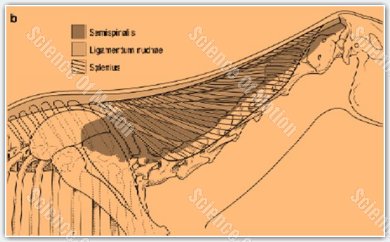
(Drawing from Michael A Simmons. Mas44@cornell.edu).
the nuchal crest behind the skull. During locomotion, the splenius exhibits bilateral activity during each forelimb stance. At the trot, the head and neck are at their lowest position in the oscillation cycle half way through the support phase of each forelimb. The splenius decelerates the downward oscillation of the head and neck that is pulled down to earth by the attraction of gravity. At impact of each front leg, the splenius contracts, resisting accelerations of gravity that are created by impact forces. At the walk, splenius activation commences before the head reaches its lower position and continue until after the head has begun rising. When, up and down oscillation of the head and neck are restricted by the use of side reins, the horse will likely compensate for the restricted oscillation of his neck leaning on the bit. Often, horses use the support of the side reins leaning on the bit instead of coordinating their upper neck muscles. 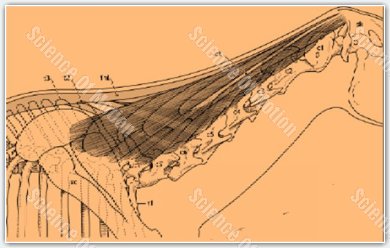
The semispinalis capitis is also inserted on the cranial thoracic vertebrae and ribs
(Drawing from Michael A Simmons. Mas44@cornell.edu).
and is attached on the crest of the skull. The semispinalis capitis is compartmented. This type of architecture allows a large diversity of movements, rotations, bending, etc. The muscle does have an internal central tendon that covers two third of the length of the muscle. There are 7 compartments above the central tendon and 6 compartments below the central tendon. Most of the alternative lateral bending and transversal rotations of the neck occurring during locomotion, are created by the semispinalis capitis. One can easily conceive that any system restricting or modifying the normal cycle of head and neck movements is going to modify limbs kinematics and vertebral column mechanism. The horse’s adaptation can be beneficial, but also damaging. It is true that some good horses are capable of sustaining suspension, cadence, a round neck and round back while working with side reins, but these horses are exception and truly do not need side reins. Bob Hope joked one day, “A bank is an institution that loans you money if you can prove that you don’t need it.” The same can be said with side reins. If a horse can adapt to the restriction of the side reins and remain functional, the horse does not need side reins. 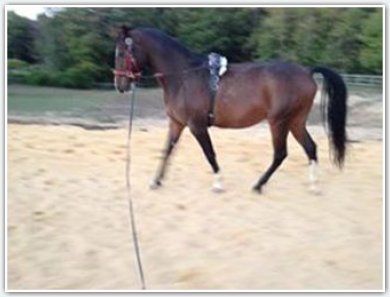
Common reactions are illustrated in this picture. The horse’s owner is a member of the Science of Motion IHTC course and, as an experiment; she placed side reins on her horse. The horse adaptation to the restriction of the side reins was very different from the theory promoted by advertising strategies. The horse shortened the neck lowering the trunk between the shoulder blades. He hollowed, arched and contracted the thoracic vertebrae, shifting the forelegs backward underneath himself. The horse became dysfunctional. The side reins were adjusted relatively long. They could have been adjusted slightly longer or slightly shorter and that would not have improved the horse reaction. The horse’s brain adapted to the restriction of the side reins protecting whatever muscle imbalance, morphological flaw or other issue was the horse’s physical situation at this moment.
Due to their more lateral attachment on the proximity of the skull, the spenius muscles are effective for lateral bending. 59% of the muscle’s fibers are slow oxidative fibers implying that postural support is a large part of the splenius’ function. These two peculiarities explain that quite often, horses strongly developed one side of the splenius as an adaptation to the side reins. A horse dealing with natural imbalance between right and left splenius will likely react to the side reins aggravating the already existing muscle imbalance. The same protective reflex mechanism can of course involve one or both semispinalis capitis creating torsion of the neck.
The horse on the picture restricts his neck afraid of the side reins unsophisticated contact. Many horses at the contrary push heavily on the bit. To do so, the upper compartments of the semispinalis capitis, which is inserted on the crest of the skull, contracts concentrically pulling the upper end of the skull backward and consequently, moving the nose forward. The skull is then pushing backward on the cervical vertebrae hampering forward transmission of the thrust generated by the hind legs through the thoracic and cervical vertebrae and causing quite often a deepening of the cervical vertebrae’s lower curve. Virchow already pointed out in 1915 that the S shape of the cervical remained whatever the neck posture. “In the dorsal direction, the cervical vertebral column can be stretched only so far that the 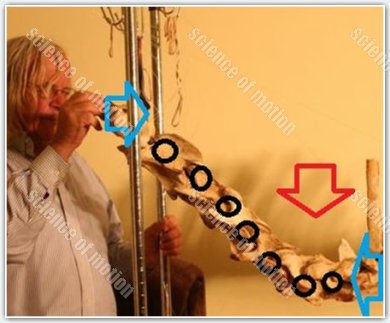 vertebrae are lying in straight line.” Slijper (1946), added to the comment that a further dorsal flexion is chiefly prevented by the ligaments. The combined action of the skull pushing backward on the cervical vertebrae and the thrust generated by the hind legs transmitted forward through the thoracolumbar spine, (blue arrows), will likely deepens the lower loop of the cervical column, (red arrow and black circles)
vertebrae are lying in straight line.” Slijper (1946), added to the comment that a further dorsal flexion is chiefly prevented by the ligaments. The combined action of the skull pushing backward on the cervical vertebrae and the thrust generated by the hind legs transmitted forward through the thoracolumbar spine, (blue arrows), will likely deepens the lower loop of the cervical column, (red arrow and black circles)
The horse on this picture exhibits deepening of the cervical vertebrae’s lower segment, lowering of the trunk between the forelegs, arching of the thoracic vertebrae and consequently, flattening of the lumbar vertebrae, without pushing on the bit. The horse explains that the same damages are created retracting the neck avoiding the rigid contact of the side reins. Some side reins are built with a rubber ring theoretically designed to avoid rigid contact. Quite often, the horse uses this rubber action to lean heavily on the bit. 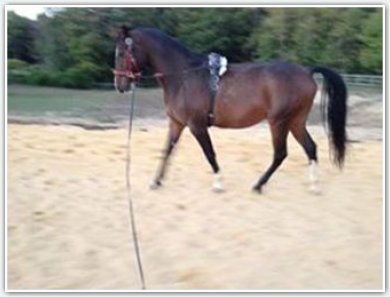
The problem with all these systems is that they dismiss the most fundamental principle of sound education. A horse always reacts protecting first any existing muscle imbalance, reflex contraction, morphological flaw, or bad habit. The rider’s capacity of analysis is the horse’s only chance of success. At the lunge, one cans change the cadence, or the size of the circle but guiding the horse brain toward the most appropriated body coordination demands a conversation that only riding the horse or working in hand the way we profess at the science of motion can achieve. For instance, if the horse travels bending the thoracic spine laterally more to the left than to the right, the horse will adapt to the side reins aggravating such lateral bending. If, as it is often the case, lateral bending is coupled with inverted rotation, the horse may adapt to the side reins increasing the intensity of the inverted rotation shifting the weight on the outside shoulder. Simplistic thinking will suggest changing the direction of the circle but this will not change the asymmetry of the bend or the intensity of the transversal rotation. The horse will turn in the opposite direction falling on the inside shoulder, shifting the croup toward the outside, or other compromise. The concept that placing the neck will makes the horse’s back functions a specific way is as naïve that the theory, “correct aids equal correct movement.” This is complete ignorance of the horse mental processing. The horse first reaction is always protecting his actual body state. If the horse “errors’ are analyzed intelligently, the horse errors inform the rider of the horse’s actual body state and the rider can decide and provide appropriated insights. If at the contrary, the horse’s errors are judges in respect of the side reins’ theoretical effects, the horse will only figure a compromise protecting his fundamental muscle imbalance, morphological flaw, memory, or other issue.
When I was training at the jumping and three day event Olympic center of Fontainebleau in France, an authority in terms of working with side reins showed me how to free jump a horse with side reins. The horse was a great athlete and his reaction to the restriction imposed by the side reins system was flying very high above the jump. The horse had the power to do that and the trainer was delighted explaining that the side reins were producing the athletic work of higher jump without exposing the horse’s legs to the stress of higher jump. What I saw was at the contrary a horse flying very high above a four feet oxer, incapable of properly using his back over the jump. Consequently, the horse landed heavily on the forelegs. What shocked me the most was that as the back was unable to properly work during the fly above the jump, the body posture at the landing was not as vertical as it should. As a result, the hind legs impacted too far back inducing abnormal stress on the hind limbs joints and thoracolumbar structure. The landing of the hind legs was painful to watch. This is basically the problem. There is a superficial way to look at it and, at this level, the side reins can please one. Once the athletic performance is analyzed for what it truly is, an athletic performance, the side reins are not preparing the horse’s physique for the effort. However, one should not throw the side reins away. They work very well as a leash for the dog.
Jean Luc Cornille 2013


